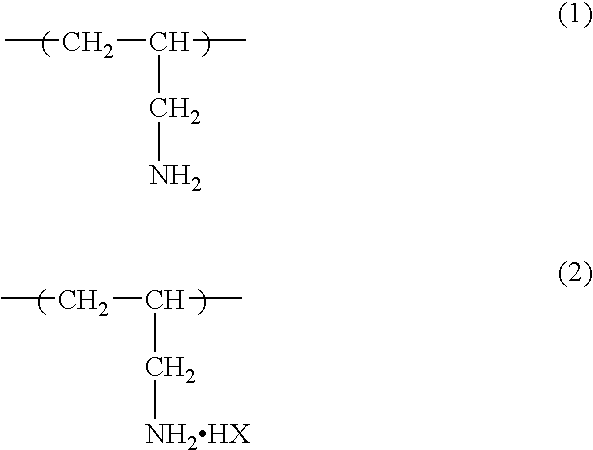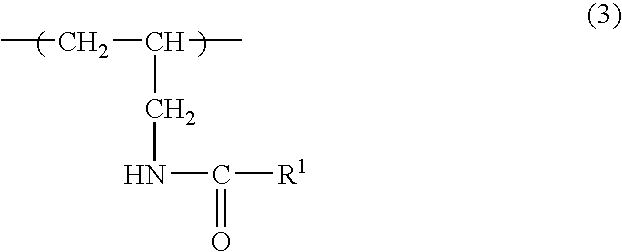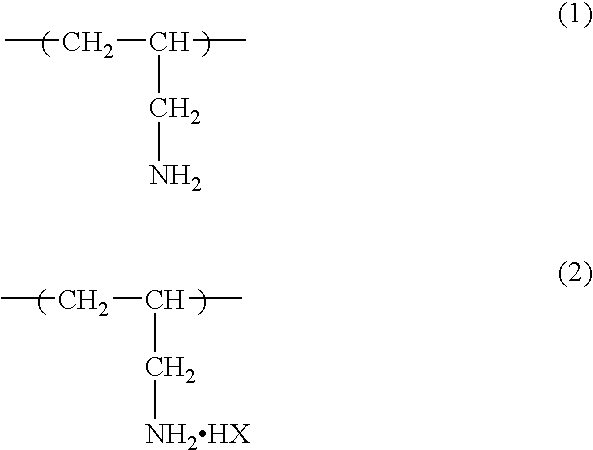Ink jet recording sheet
a technology of recording sheet and ink jet, which is applied in the direction of thermography, duplication/marking methods, coatings, etc., can solve the problems of inability to achieve sufficient improvement of image quality, affecting the appearance of the image, etc., to achieve high transparency and water resistance, low swelling, and non-ionic properties
- Summary
- Abstract
- Description
- Claims
- Application Information
AI Technical Summary
Benefits of technology
Problems solved by technology
Method used
Image
Examples
example 1
(Preparation of Coating Solution A for Ink Receiving Layer)
[0184] Vapor phase silica (100 parts, trade name: Aerosil 300, a product of Aerosil Co., average particle size of primary particle of 7 nm, BET specific surface area of 300 m2 / g), 20% by mass aqueous solution of 50 mol % methoxycarbonyl denatured polyallylamine hydrochloride (40 parts, molecular weight of about 15,000) and ion exchanged water (691 parts) were mixed and dispersed using an agitation device, and the mixture was treated using a wet type nanomizer. Then, 5% by mass aqueous solution of polyvinyl alcohol (367 parts, trade name: PVA-145, a product of Kuraray Co., Ltd., saponification degree of 99%, average polymerization degree of 4,500) and a small amount of antifoaming agent, dispersing agent and water were added. As a result, a coating solution A for ink receiving layer having a solid component concentration of 8% was obtained.
(Preparation of Coating Solution B for Ink Receiving Layer)
[0185] To a 20% dispers...
examples 2-10
[0187] Ink jet recording sheet was prepared in the same manner as in Example 1 except that the following compounds were used instead of 50 mol % methoxycarbonyl denatured polyallylamine hydrochloride (molecular weight of about 15,000):
[0188] In Example 2: 50 mol % methoxycarbonyl denatured polyallylamine hydrochloride (molecular weight of about 60,000);
[0189] In Example 3: 30 mol % methoxycarbonyl denatured polyallylamine hydrochloride (molecular weight of about 15,000);
[0190] In Example 4: 20 mol % methoxycarbonyl denatured polyallylamine hydrochloride (molecular weight of about 15,000);
[0191] In Example 5: methane sulfonate of 50 mol % methoxycarbonyl denatured polyallylamine (molecular weight of about 15,000);
[0192] In Example 6: 50 mol % acetyl denatured polyallylamine hydrochloride (molecular weight of about 15,000);
[0193] In Example 7: 50 mol % ethoxycarbonyl denatured polyallylamine hydrochloride (molecular weight of about 15,000);
[0194] In Example 8: 50 mol % isopropo...
examples 11-12
[0197] Ink jet recording sheet was prepared in the same manner as in Example 1 except that the following compound was further added to the coating solution A for ink receiving layer:
[0198] In Example 11: 100 parts of basic aluminum acetate aqueous solution (concentration of 5% by mass converted to Al2O3); and
[0199] In Example 12: 15 parts of zirconyl acetate aqueous solution (concentration of 30% by mass converted to ZrO2)
PUM
| Property | Measurement | Unit |
|---|---|---|
| primary particle size | aaaaa | aaaaa |
| particle size | aaaaa | aaaaa |
| average primary particle size | aaaaa | aaaaa |
Abstract
Description
Claims
Application Information
 Login to View More
Login to View More - R&D
- Intellectual Property
- Life Sciences
- Materials
- Tech Scout
- Unparalleled Data Quality
- Higher Quality Content
- 60% Fewer Hallucinations
Browse by: Latest US Patents, China's latest patents, Technical Efficacy Thesaurus, Application Domain, Technology Topic, Popular Technical Reports.
© 2025 PatSnap. All rights reserved.Legal|Privacy policy|Modern Slavery Act Transparency Statement|Sitemap|About US| Contact US: help@patsnap.com



